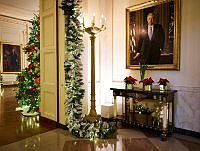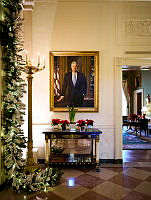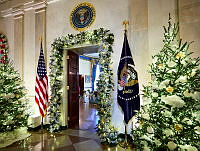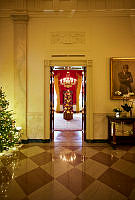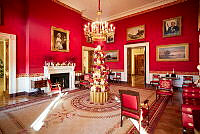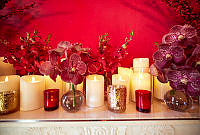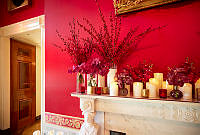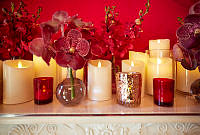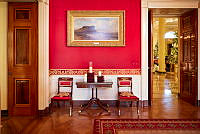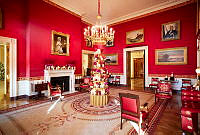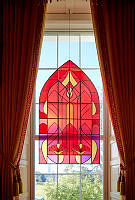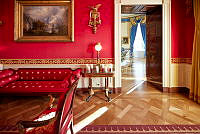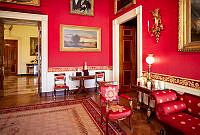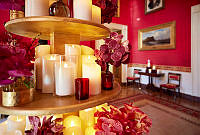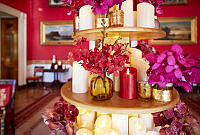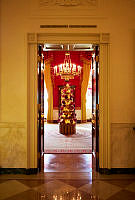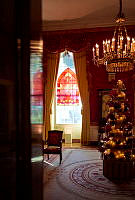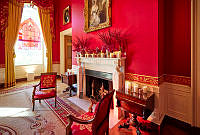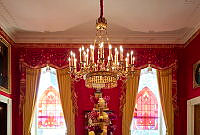Glimpses of the Old Family Dining Room
Copyright © February 19, 2015 White House Historical Association. All rights reserved under international copyright conventions. No part of this article may be reproduced or utilized in any form or by any means, electronic or mechanical, including photocopying, recording, or by any information storage and retrieval system, without permission in writing from the publisher. Requests for reprint permissions should be addressed to books@whha.org
The Family Dining Room on the State Floor of the White House today is used primarily for smaller formal dinners and working lunches. The space, adjacent to the State Dining Room, also often serves as a staging area for State Dinners. White House families have traditionally dined in the Family Dining Room since about 1825 when President John Quincy Adams and First Lady Louisa Catherine Adams began to take their meals there. Designated the “small dining room” or “private dining room,” presidents and their families historically took all of their meals here before 1962. President Herbert Hoover and First Lady Lou Hoover were the exception – they called the space the “Breakfast room” because they ate dinners in the State Dining Room.1

White House families took their private meals in the Family Dining Room adjacent to the State Dining Room. Photographed for the first time in 1889.
By 1962, First Lady Jacqueline Kennedy had created a new family dining room on the Second Floor in the private quarters in a northwest bedroom space that had been used as a sitting room by Margaret Truman and Mamie Eisenhower’s mother. The Family Dining Room’s present design reflects its reconstruction during the Truman Renovation (1948-1952). The elegant plasterwork and vaulted ceiling were inspired by the 1902 neoclassical renovation by McKim, Mead and White. A distinctive French marble mantel was installed in 1962.2

The Family Dining Room with the Colonial Revival furnishings made for the room in 1902.
White House Historical Association/White House CollectionSince the first photograph of the room was taken in 1889, the camera has captured the changes in the Family Dining Room that evolved as all of the rooms, walls, and furnishings of the White House were adapted to meet the needs and convenience of the first families throughout the history of the house. Some highlights of the room’s history: the Grants hosted “family dinners” in this room usually with a dozen or so guests personally known by the president and first lady. The walls of the room at that time were finished with wallpaper that resembled oak paneling that matched the oak furniture in the State Dining Room. It was the room that the Grant family dined in every day.3

The Family Dining Room after the Truman Renovation, 1952.
During the Chester A. Arthur administration the Family Dining Room had rich, dark wallpapers applied in three horizontal bands with a frieze, ground and dado making the simple chamber seem far more complex. A coal grate was torn out and a log fireplace that had warmed early presidents was reopened and framed by polished brass and Minton tiles. Two towering sideboards lined with brasses and porcelains, including the Hayes dinnerware, glinted from the light of a blazing fireplace. President Arthur preferred to host small dinners in this room rather than big banquets in the State Dining Room.4

Family Dining Room after the Kennedy restoration, ca. 1963.
The 1902 Roosevelt renovation brought Colonial Revival furnishings to the Family Dining Room designed by McKim, Mead and White and produced by A. H. Davenport of Boston. A glass chandelier and sconces by the prominent lighting firm of E.H. Caldwell of New York, specially designed mahogany chairs and a mirror in the late-eighteenth-century Chippendale style, a Sheraton style mahogany sideboard and china cabinet, and a new mahogany console with eagle supports inspired by Anthony Quervelle’s pier tables for Andrew Jackson’s East Room reflected the widespread interest in antiques and reproductions of furnishings that recalled the origins of the nation and its idealized past.5

Federal period furnishings in the Family Dining Room as it appeared in 2010.
The redecoration of the Family Dining Room during the Kennedy administration came under the direction of New York interior designer Mrs. Henry “Sister” Parish II, chairman of the Fine Arts Committee of the White House, Henry Francis du Pont, and preservation architect Robert Raley. Parish and du Pont concentrated on including American Federal furniture in the Sheraton and Hepplewhite styles. Raley removed a series of wood moldings that had created panel division in the upper portions of the walls and devised permanent window valances to reduce the interior height of the windows without changing the exterior appearance. Raley and du Pont selected the dark-green and white marble mantel with a large central eagle in its tablet. The bright yellow painted walls accented by white woodwork and decorative plaster completed the interior design of a room converted for use as a smaller dining room for presidential working breakfasts, lunches, and occasional private dinners with dignitaries and special guests.6

The Family Dining Room after the 2015 refurbishment.
With the support of the White House Historical Association, the Family Dining Room was refurbished in 2015 to showcase modern art and design. The room’s new gray wall color, gilded metal and glass wall sconces, red draperies, and a wool rug adapted from a pictorial weaving – “Black, White, and Gray” by Anni Albers – creates a space that well complements four works of abstract art, recently acquired for the White House collection and admired by the Obamas, which have been hung in the room: “Resurrection,” by Alma Thomas, “Early Bloomer,” by Robert Rauschenberg, and two by Josef Albers, “Study for Homage to the Square” and “Homage to the Square.”





